|
Category
|
Archaeological monuments of Surkhandarya. Kampyrtepa. Dalvarzintepa.Kampyrtepa 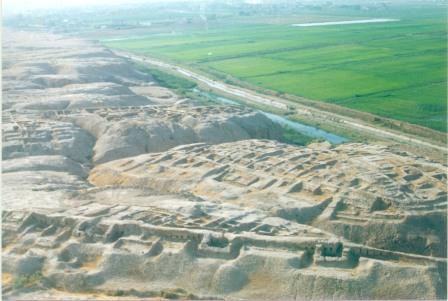 On the steep bank of the Amu Darya River, 30 kilometers west of Termez are the ruins of the ancient city Kampyrtepa, identified by scientists at the legendary Alexandria Oxiana (Amu Darya). The total area of the preserved part of the fortress is about 4 hectares. Kampyrtepa is a citadel, surrounded by a moat, and the "lower city", walled with towers. Citadel, which has multimeter layers of the Hellenistic period, began to adapt themselves to the end of the IV c. BC. Building the "lower city" made on a single plan in the beginning I c. BC and lasted until the reign of the Kushan king Kanishka I (the first third of the II c. BC). On the steep bank of the Amu Darya River, 30 kilometers west of Termez are the ruins of the ancient city Kampyrtepa, identified by scientists at the legendary Alexandria Oxiana (Amu Darya). The total area of the preserved part of the fortress is about 4 hectares. Kampyrtepa is a citadel, surrounded by a moat, and the "lower city", walled with towers. Citadel, which has multimeter layers of the Hellenistic period, began to adapt themselves to the end of the IV c. BC. Building the "lower city" made on a single plan in the beginning I c. BC and lasted until the reign of the Kushan king Kanishka I (the first third of the II c. BC).The monument, opened by Academician E.V.Rtveladze in 1972, he studied for 30 years. Today, studied more than 70% of its territory. The Kampyrtepa fortress has a number of bright characteristics. Open this array is a one-time Kushan residential development dated from the reign of the kings Soter Megas to Kanishka I (second half of the I century BC - the first half of the II c. AD). The complex material culture of these neighborhoods is the reference period for the emergence and flourishing of the Kushan Empire.
An important feature of the monument is its pronounced functional significance. The settlement was located on the edge of the floodplain terrace of the right high bank of the Amu Darya (in ancient times - Oxus), and was founded to serve the ferry across it. Terrace length of about 2 km grid is cut with gentle mouths of the ravines, and has natural circuses, convenient device crossings. It was used in this capacity since Achaemenid times, as evidenced by the Shortepa fortress on the western edge of the terrace. Later, at the end of the IV c. BC ferry transferred to Kampyrtepa and from the early Middle Ages it performs the function Shurobkurgan. In the port of Kampyrtepa a carried transshipment a large amount of different products that were on the way here from Afrasiab - the capital of Sogdiana to the capital of Bactria, located 70 km south of the fort, and then go to the south-east, to India.
Studies on the Kampyrtepa citadel found that in the Hellenistic and Greece-Baktrian time (late IV – late II cent. BC) from the outside - just north of before-gate facilities and ramp were building arsenal or port type. In the following it Kushan (late II - I c. BC) period in the guardhouse (guard house), found ceramic matrix for the replication of terra cotta designs depicting Athena with a spear. As we know, this is also considered the patron goddess of warriors.
At Kampyrtepa held a unique work of conservation projects. The experience of conservation and reconstruction Kampyrtepa is the most successful in the region. Restoration of the outer city wall and one quarter of the Kushan, conducted under the sponsorship of the American Congress, with maximum use made of the ancient building techniques. For forming adobe bricks used loess, which was taken at the foot of the ramparts, dried on the ground and was placed on a clay solution. Fortress Kampyrtepa included in the list of cultural heritage protected by UNESCO. The Settlement Dalverzintepa
Kushan Empire reached its zenith under King Kanishka I, when a powerful state has reached such a high level of development and stability that compete in trade and cultural exchanges with the other three Eurasian world super-empires of ancient - Roman, Parthian and Chinese Han. These four "Great powers" of antiquity, has extended its influence across the Atlantic to the Pacific. Later, historians call this period (I-IV c) is "Imperial". It was at this time from China through the lands of Kushan and Parthians in Roman Syria stretches the largest in the history of mankind caravan route - Great Silk Road.
One of the reasons for the creation of such circumstances in the country has been pursued by Emperor Kanishka policy of ethnic and religious tolerance. Caravans of foreign merchants and pilgrims gladly traveled the Kushan empire, as in this country was founded are very supportive and fertile environment for the friendly coexistence of all nations and people, regardless of their race, and spiritual orientation. At the same time, flowering occurred, redistribution and rebroadcasting of Buddhism on the Silk Road in the direction of Eastern Turkestan, China, and then, somewhat later, the Korea and Japan. Archaeologically Dalverzintepa almost the "sterile" ancient city, the excavations which provide an opportunity to study urban features, fortification, architecture, art and material culture of Northern Bactria, especially for the time of the Great Kushans.
A systematic study of Dalverzintepa began in 1967. Archaeologists excavated mound area of 47 hectares was literally crammed with artifacts. In the northwestern part of the settlement excavated the temple of the goddess of the Bactrian, where statues of deities and found unique pieces of wall paintings depicting the priests and infants. The center found a Buddhist temple II-III centuries. In the suburban area discovered the ruins of another Buddhist temple, erected, according to the finds of coins, even earlier - about I c. Both the religious complex were once decorated with clay and plaster sculptures. Archaeologists have found more than three dozen magnificent sculptures of various sizes - from half to 3 and 4 meters high. Among them are numerous statues of Buddha, bodhisattvas and other Buddhist figures, sculptures of the ruler and his heir, the noble ladies, lords.
The central part of the city occupied th e houses of rich citizens, built-up residential houses with spacious “aiwans”, ceremonial rooms and outbuildings. In many homes the number of rooms amounted to two or even three dozen. In one of these homes in 1972 during
Of great interest among the findings represent the figures of musicians, who are talking about peoples musical tastes of the time. Among the musical instruments of the time recognizable short lute. In the musician's posture (sitting in a game) you can see the tradition Hellinistic Greece. Terracotta figure of a musician gives an idea of the Bactrian harp - an instrument "celestial music", especially revered in the Middle East. The results of the excavations on the site Dalverzintepa, once the principal city of the former gaining the power of the Kushan Empire, provides insights on how the Kushan culture assimilated and creatively recycled different traditions of different civilizations, located on the Silk Road. The Settlement Ayritom
Kara-Kamar
Layout of the premises of Kara-Kamar has no analogues among the man-made caves in the East. This is a cave town: three large halls and many smaller buildings framed on three sides by the cut in the rock mass a huge rectangular "courtyard" area of about two hundred square meters and a height of ten meters. Its open end hanging over the ledge steeper. Noticeable tendency of builders to link architecture with the natural cave environment. Inside the cave inscriptions are found on the Bactrian, Greek, Arabic and other languages. A three-line found there are two Latin inscriptions have become a sensation in the scientific world, as Bactria was in the many thousands of kilometers away from the Roman Empire. The inscriptions may recognize the name - "Rex Gaius" and, probably, the name of the 15th Roman Legion "Apolinaris." 15th Pannonian Legion was formed in 53 BC by Julius Caesar, and in 37 BC this Legion took part in the Parthian campaign by Antony ended a complete defeat and surrender of the entire Roman army. The Parthian king Orod II settled Romans war prisoners in Margiana on the border of Sogdiana and Baktria, but in 20 BC King Phraat IV returned them to August. It was the only return Roman captives by the enemy. It is noteworthy that the Legion and later often took an active part in the Roman-Parthian wars. But there is another version: Gaius Rex could be a member of one of the Roman trade or diplomatic missions sent to the Kushan Bactria. The cave complex is a complete analogy with the so-called “mitreums” - a kind of temple structures fans Mitra - syncretic religion that arose in the beginning of our era. It originated among the legions, and then spread throughout the Roman Empire, a vast territory stretching from England to Iran. In preparing the articles used material sites www.zerkalo21.uz, kampyrtepa.narod.ru
|
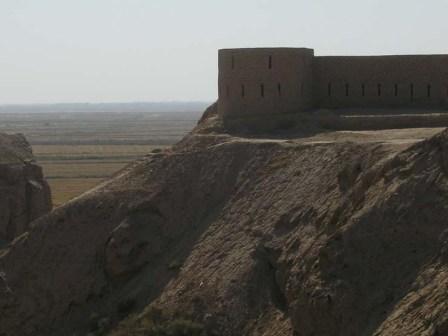 Bactrian Detachment of the Central Asian Archaeological Expedition of the Archaeology Institute under the direction of N.D.Dvurechenskaya began excavations east of "downtown" Kampyrtepa in 2004. Until that time it was thought that throughout the "lower city" that housed living quarters, built on a single plan in Early Kushan time (I c. BC), and older buildings do not exist. However, in the first work season in the study of the monument under the Kushan layers were able to identify three construction periods: Early Hellinistic, Greece-Bactrian and Kushan-Yuechzhian.
Bactrian Detachment of the Central Asian Archaeological Expedition of the Archaeology Institute under the direction of N.D.Dvurechenskaya began excavations east of "downtown" Kampyrtepa in 2004. Until that time it was thought that throughout the "lower city" that housed living quarters, built on a single plan in Early Kushan time (I c. BC), and older buildings do not exist. However, in the first work season in the study of the monument under the Kushan layers were able to identify three construction periods: Early Hellinistic, Greece-Bactrian and Kushan-Yuechzhian.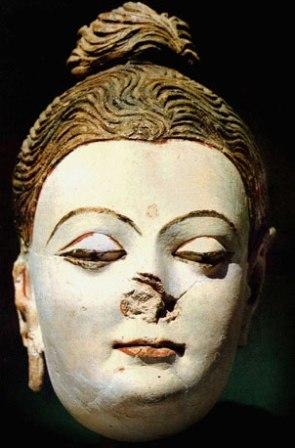 During the study Kampyrtepa made some interesting discoveries in the field of material and artistic culture of Kushan Bactria. In particular, it was a sensational discovery of the Uzbek archaeologists near the city gates, ruins of Buddhist shrines. And from the base of one of its walls was recovered terracotta sculpture of a seated Buddha first half of II century AD. It is noteworthy that it is virtually the only facility of its kind in this ancient city. So far, almost entirely excavated building its present places of worship related as previously thought, with only local and Zoroastrian faiths. The found sculpture of the Buddha is unique, though, and displays the classic iconography of the image of the deity - crossed in a pose of yoga legs, lying on my feet hands, hands that touch under the belly, elongated earlobes, hair gathered into a chignon at the nape – “ushnisha”. The closest analogy to this image can be the relief of the Buddha on the "Triad" of Fayaztepa, as well as "Buddha-Mazda" from the wall paintings in a cave temples Karatepa (I century AD). This is an image that conveys the image of a syncretic, bringing together the features of the supreme deities of the then two world religions - Buddhism, Zoroastrianism, respectively, of the Buddha and Ahura Mazda (translated as "Lord Wisdom").
During the study Kampyrtepa made some interesting discoveries in the field of material and artistic culture of Kushan Bactria. In particular, it was a sensational discovery of the Uzbek archaeologists near the city gates, ruins of Buddhist shrines. And from the base of one of its walls was recovered terracotta sculpture of a seated Buddha first half of II century AD. It is noteworthy that it is virtually the only facility of its kind in this ancient city. So far, almost entirely excavated building its present places of worship related as previously thought, with only local and Zoroastrian faiths. The found sculpture of the Buddha is unique, though, and displays the classic iconography of the image of the deity - crossed in a pose of yoga legs, lying on my feet hands, hands that touch under the belly, elongated earlobes, hair gathered into a chignon at the nape – “ushnisha”. The closest analogy to this image can be the relief of the Buddha on the "Triad" of Fayaztepa, as well as "Buddha-Mazda" from the wall paintings in a cave temples Karatepa (I century AD). This is an image that conveys the image of a syncretic, bringing together the features of the supreme deities of the then two world religions - Buddhism, Zoroastrianism, respectively, of the Buddha and Ahura Mazda (translated as "Lord Wisdom").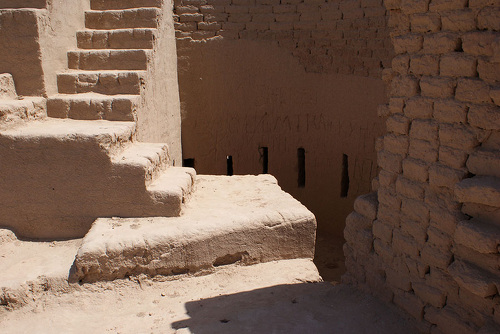 Kampyrtepa - this is next ancient port town on the Amu Darya, the third in a row after Ayrtam and metropolitan Tarmita (fort Old Termez), in the twenty-mile district where they reside. The first - above the river, and east, the second - below and to the west. Moreover, researchers have previously found that Kampyrtepa, located on the the ancient ferry Burdaguy, served as the hotel and customs. Incidentally, the name of it comes from the Greek word Pandoki-Pandoheon, which means "House of hospitality."
Kampyrtepa - this is next ancient port town on the Amu Darya, the third in a row after Ayrtam and metropolitan Tarmita (fort Old Termez), in the twenty-mile district where they reside. The first - above the river, and east, the second - below and to the west. Moreover, researchers have previously found that Kampyrtepa, located on the the ancient ferry Burdaguy, served as the hotel and customs. Incidentally, the name of it comes from the Greek word Pandoki-Pandoheon, which means "House of hospitality."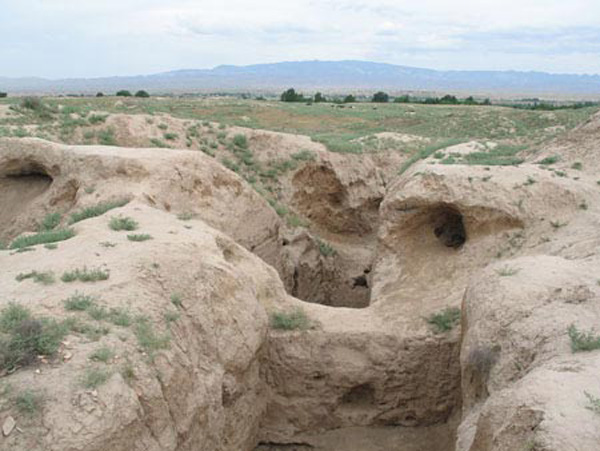 The Settlement Dalverzintepa is located in Shurchi District of Surkhandarya region, in a fertile Surkhandarya valley. Its beginning dates back to the III c. BC, have flourished in the Kushan Empire era (I-IV c. BC), the decline - in the IV-V centuries. In the heyday of the city was surrounded by a defensive wall of a length of about 2.5 km thick and 10 m wide moat. In the city walls and towers were built shooting galleries and casemates and on ridges - fighting moves and platforms for archers, slingers, and stone-throwing guns.
The Settlement Dalverzintepa is located in Shurchi District of Surkhandarya region, in a fertile Surkhandarya valley. Its beginning dates back to the III c. BC, have flourished in the Kushan Empire era (I-IV c. BC), the decline - in the IV-V centuries. In the heyday of the city was surrounded by a defensive wall of a length of about 2.5 km thick and 10 m wide moat. In the city walls and towers were built shooting galleries and casemates and on ridges - fighting moves and platforms for archers, slingers, and stone-throwing guns.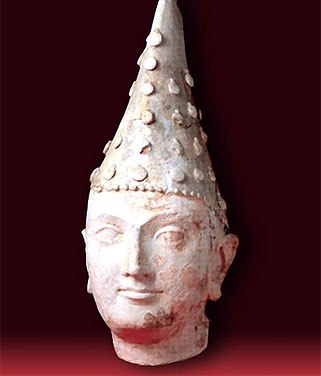 One of the most significant achievements of the Kushan period was a high level of culture, which were fused to achieve a local civilization of the ancient type, the best traditions of Hellenistic culture, refinement of art in India and a special style, brought to the expanse of nomadic tribes of Asia.
One of the most significant achievements of the Kushan period was a high level of culture, which were fused to achieve a local civilization of the ancient type, the best traditions of Hellenistic culture, refinement of art in India and a special style, brought to the expanse of nomadic tribes of Asia.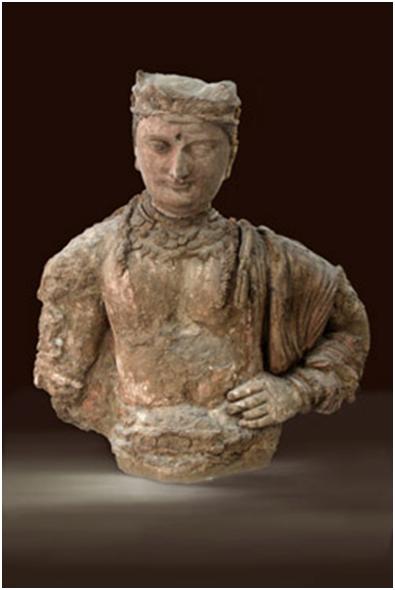 According to G.Pugachenkova, "a comparison of historical and archaeological data gives reason to identify it with the original capital of the Kushan, located north of the Amu Darya, which under the name of Hojo appears in ancient Chinese chronicles."
According to G.Pugachenkova, "a comparison of historical and archaeological data gives reason to identify it with the original capital of the Kushan, located north of the Amu Darya, which under the name of Hojo appears in ancient Chinese chronicles."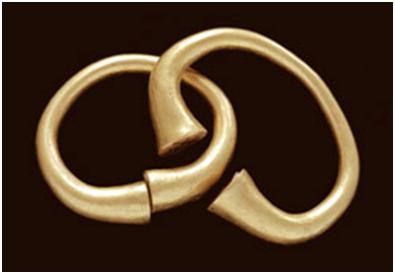 Part of the archaeological collection Dalverzintepa exhibited at exhibitions in Japan, Switzerland, Germany, France, USA, Malaysia, the Republic of Korea.
Part of the archaeological collection Dalverzintepa exhibited at exhibitions in Japan, Switzerland, Germany, France, USA, Malaysia, the Republic of Korea.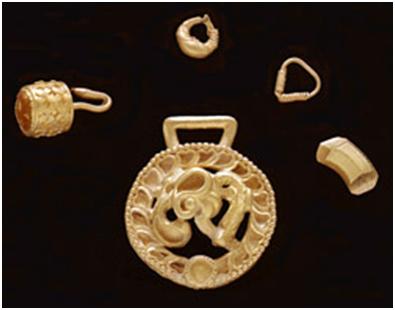 excavations, archaeologists have discovered the largest in the history of the region Dalverzin hoard of gold objects weighing approximately 36 kg, referring to the I c. Dalverzin treasure for its scientific significance is not inferior to the famous Amu Darya treasure, preserved in the British Museum. For the first time throughout the Middle East found a treasure of precious Kushan products, moreover, has historically adjusted by finding it in the archaeological layer.
excavations, archaeologists have discovered the largest in the history of the region Dalverzin hoard of gold objects weighing approximately 36 kg, referring to the I c. Dalverzin treasure for its scientific significance is not inferior to the famous Amu Darya treasure, preserved in the British Museum. For the first time throughout the Middle East found a treasure of precious Kushan products, moreover, has historically adjusted by finding it in the archaeological layer.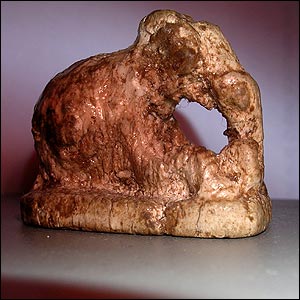 During the excavation also found numerous articles of ivory, in cluding the oldest chess pieces in the world (I-II c. N. E.). As well as products made of polished stone, copper coins, beads made of precious stones, thin-walled ceramic related to the Greece-Bactrian era.
During the excavation also found numerous articles of ivory, in cluding the oldest chess pieces in the world (I-II c. N. E.). As well as products made of polished stone, copper coins, beads made of precious stones, thin-walled ceramic related to the Greece-Bactrian era.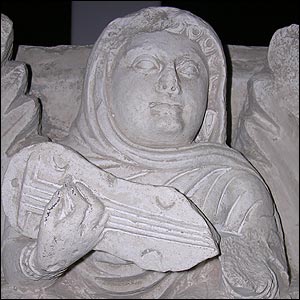 Ayritom - settlement, consisting of a number of separate sites along the right bank of the Amu Darya River, 18 km east of Termez, a total area of 90 hectares. In the Greece-Bactrian times (in the II century BC) in Ayritam erected monumental building - the fort. Since the turn of our era, in connection with the penetration of Buddhism in northern Bactria in Ayritam begins extensive construction of Buddhist religious monuments. The ruins of the Greece-Bactrian building used as a platform for the Buddhist complex. In the Kushan period in Ayritam formed a large Buddhist temple and monastery center, stretching nearly 3 miles along the banks of the Amu Darya. The buildings of the complex were richly decorated with sculpture and architectural decoration, made of marble-like limestone. Used in the construction of burnt brick. Around the complex there were economic-production services, including identified Brick-roasting and pottery kilns. In the second half of III century Airtam is in decline and no longer be restored. Scientist M.Masson, which conducted research here was discovered in 1932 some great Buddhist statues and plates depicting musicians and garland bearers.
Ayritom - settlement, consisting of a number of separate sites along the right bank of the Amu Darya River, 18 km east of Termez, a total area of 90 hectares. In the Greece-Bactrian times (in the II century BC) in Ayritam erected monumental building - the fort. Since the turn of our era, in connection with the penetration of Buddhism in northern Bactria in Ayritam begins extensive construction of Buddhist religious monuments. The ruins of the Greece-Bactrian building used as a platform for the Buddhist complex. In the Kushan period in Ayritam formed a large Buddhist temple and monastery center, stretching nearly 3 miles along the banks of the Amu Darya. The buildings of the complex were richly decorated with sculpture and architectural decoration, made of marble-like limestone. Used in the construction of burnt brick. Around the complex there were economic-production services, including identified Brick-roasting and pottery kilns. In the second half of III century Airtam is in decline and no longer be restored. Scientist M.Masson, which conducted research here was discovered in 1932 some great Buddhist statues and plates depicting musicians and garland bearers.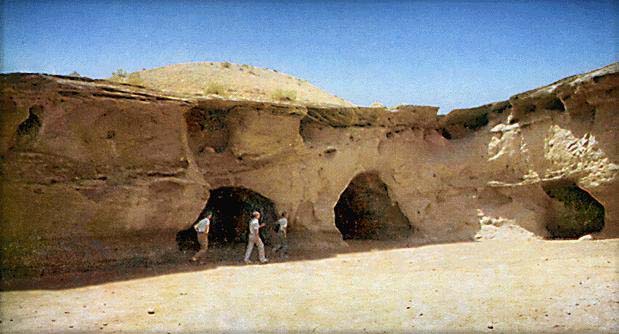 Kara-Kamar - unique cave complex carved into the rocky rid ges of the vast Sherabad ridge on the border of Uzbekistan and Turkmenistan, which is almost two thousand years. For the first time this cave was discovered in 1875 by the famous geographer and traveler N. Maiev during the reconnaissance of the roads in Eastern Bukhara.
Kara-Kamar - unique cave complex carved into the rocky rid ges of the vast Sherabad ridge on the border of Uzbekistan and Turkmenistan, which is almost two thousand years. For the first time this cave was discovered in 1875 by the famous geographer and traveler N. Maiev during the reconnaissance of the roads in Eastern Bukhara.














